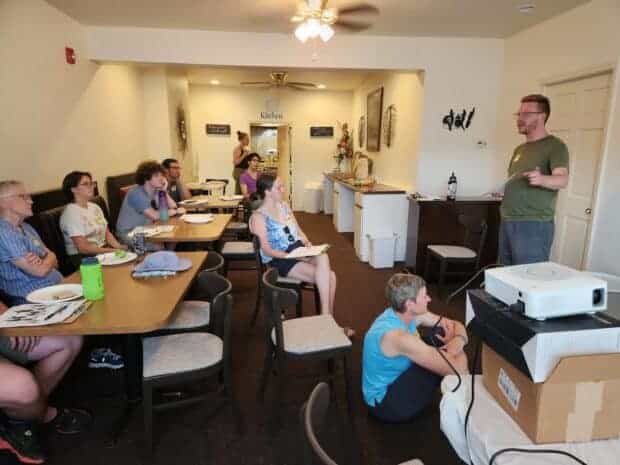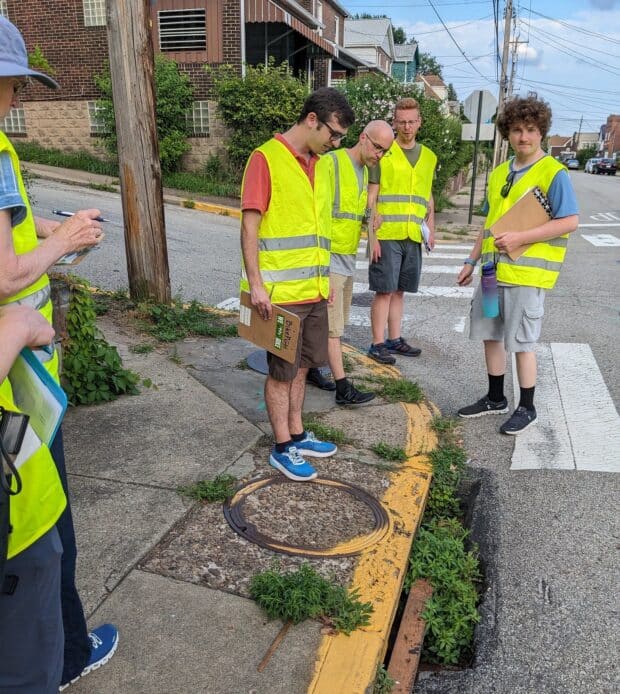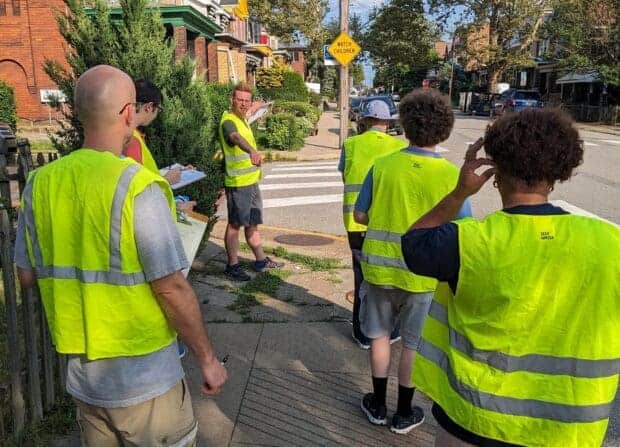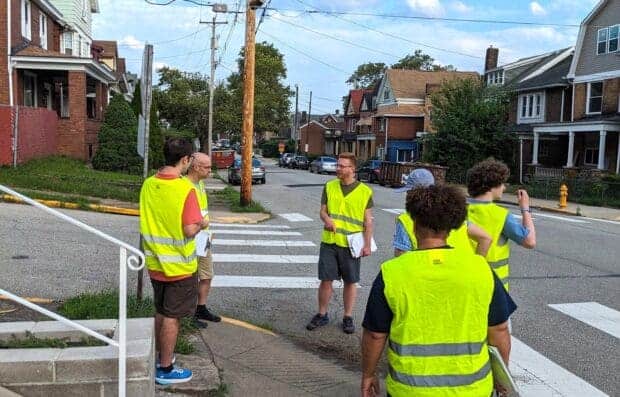



What does it mean to be a walkable community, and how do we get there?
Another month at PA Walking College is under our Advocacy Manager, Seth’s, belt! To recap, Seth was accepted into the 2023 Pennsylvania State Walking College Fellowship Program through America Walks and AARP. We’ve been following along with him each month as he grows his skills to advocate for people who walk and roll in our communities.
If you missed it, check out our blogs from (Month 1) (Month 2) to get a recap of his experience, and continue reading below to get a closer look at how it’s all coming together to create real change on the ground here in Pittsburgh.
Q: What were you excited to learn at Walking College this month?
Seth: The primary purpose of my involvement in Walking College is to get resources, skills, and knowledge to share with our members and advocates. This month, we looked very practically at how to identify problems regarding walkability in communities, and specific solutions to address those problems. To do that, one of the main tools we use is the Walk Audit.
I was able to put the skills I learned at Walking College to direct use for the first time by leading a Walk Audit training for advocates from across the city to learn how they can do their own walk audits. The Walk Audit Training I led was a part of BikePGH’s Advocacy Training Series, and the goal was to help community members identify problems they could address with an advocacy campaign. If you’d like to learn more, check out our Advocacy Training Series blog and sign up for a session here!
Q: That’s awesome, let’s talk more about that! What was useful about this Walk Audit in particular?
Seth: There are essentially two types of Walk Audits you can do: 1.) “Observational,” the first step in identifying problems to solve in the future through campaigns. 2.) “Educational,” when we know what changes we want to see, and we invite decision-makers such as council people, the mayor, or city planners to attend the walk audit and learn about the problems we’ve observed and the solution(s) we propose. The Walk Audit we engaged in for the training was an “observational” walk audit.
On July 20, BikePGH brought together ~15 advocates from around the city to Swissvale, where they learned how they can do Walk Audits in their own neighborhoods. A Walk Audit involves walking through an area or observing a stretch of road to identify what challenges there are to people who walk through the area. The idea is to start thinking about solutions to make it safer and more enjoyable for people to walk in that area. Check out the resource below to learn more about the elements of a walk audit.
At our Walk Audit Training, each participant received a map of Woodstock Ave to mark up and take direct notes. We also provided worksheets developed by AARP to help take stock of what’s working and what isn’t on a particular street. People had a chance to start noticing things they didn’t notice before. Once you see the things that don’t work, you’ll start noticing them everywhere you go.
Q: What are some of those problems you noticed on your Woodstock Ave Walk Audit?
Seth: The three big Woodstock Ave issues we noticed:
- A lack of stop signs. We observed drivers making fast, unsafe turns, speeding and rolling through the few stop signs there are.
- Generally broken sidewalks with missing sections, uneven cracks, including sidewalks with curbs that are almost flush with the road pavement. This happens when new asphalt builds up over time and you lose the curb when they repave. This is dangerous because it leads to drivers parking on the sidewalk… and we all know how we feel about that!
- Narrow sidewalks, caused by the overgrown trees, brush from yard overgrowth, narrowing the sidewalks making it difficult for people to pass, especially people who use wheelchairs and mobility devices, strollers, etc. Narrow sidewalks are dangerous because they force people into the street.
We also got to talk about what does it “feel like” to be walking on the street? Is it safe? Does it feel comfortable? Does it feel unsafe? One takeaway was we noticed the tree-lined sections caused drivers to slow down. With less street trees, it felt less comfortable and cars tended to go faster. This all points to potential solutions: Take care of and plant trees + trim back overgrowth + invest in repairing sidewalks + install stop signs and traffic calming, like speed humps!
One of the things that was an unintended outcome was we ended up being asked by neighbors “Hey whatcha doin???” To which we responded, “We’re looking at the walking safety of the street!“ — Even little kids came up and asked what we were doing, “What’s this all about, Mr Seth??” From these conversations, we noted that the neighbors want speed bumps, because the car speeds make it feel unsafe. We were fortunate to hear right from these neighbors in real time! This “real time” interaction with neighbors shows what a powerful organizing tool the Walk Audit truly is.
Q: What are some possible solutions to the hazards you identified??
Seth: The walk audit helps you to see problems and start to brainstorm solutions. When thinking about making a community walkable, there are four main elements you wanna see in a Walkable Community. Use these as ways to prompt your thinking. Whatever the reason for your walk, what would make your walks feel more safe, comfortable, and interesting?
– A reason to walk – For example: support local biz within walking distance to you. Support schools to stay within walking distance of people in your community. Encouraging and supporting public transit.
– A safe walk – For example: traffic calming measures. Roundabouts, speed humps, curb cuts, etc.
– A comfortable walk – For example: clearing overgrown brush. Clear litter. Plant trees, add places to sit, and ensure adequate lighting.
– An interesting walk – For example: making the walk beautiful. Encouraging public art. Doing events. Having fun. Block parties. Porch music fests. Pop Ups.
Q: Can anyone do a walk audit, and should you seek out particular groups of people to engage in walk audits?
Seth: Yes, anyone can do a Walk Audit! Ideally, you want to have lots of people with different abilities and all walks of life to join you. If you can’t do that, bring a stroller or a cart or something with you that gives you a felt experience of being on wheels, dealing with obstructions, etc. The participants said the Walk Audit experience really helped them to learn how to observe from a few different perspectives what the challenges on a given street are, including people who might use mobility aids.
After the walk audit, we went back and debriefed on best practices – What we did and what they can do in their neighborhood. One of the key pieces is to engage and involve a diversity of road users in the walk audit – from children playing to commuters, to people recreating, to bikers, to transit riders, to people with disabilities who encounter challenges that able-bodied people may not notice.
Q: Do you have any interesting resources to share with us for this month?
- Video on pop-up safety “tactical urbanism” projects:
Q: In terms of the walk audit, what’s next? How might these skills translate to real world change (in PGH or beyond)?
Seth: So after leading that Walk Audit, we now have people who are prepared to lead Walk Audits in their own communities— Exciting! Now that we have the basis of this training, we can bring it all over the city…. so please reach out to us if you want help with a Walk Audit training in your neighborhood!
I can either connect you with your local bike/ped group to plan an event together, or we can talk about starting one in your neighborhood.
Now that we’re identifying problems and possible solutions – it’s time to develop campaign strategies to implement those solutions. That’s what our training on August 19th is all about!
Thanks, Seth, for once again sharing this all with us as you continue your learning at PA Walking College! Stay tuned next month as we learn more about this curriculum and how it will be put to use in our community. Next time we’ll be talking a little more about Mobility Justice and how to change car-centric roads.
And again, if you want to get involved with BikePGH Advocacy right now, make sure to check out our Advocacy Training Series, we have one more session on August 19 available!